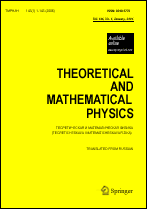|
|
Teoreticheskaya i Matematicheskaya Fizika, 1994, Volume 100, Number 3, Pages 458–475
(Mi tmf1662)
|
 |
|
 |
This article is cited in 1 scientific paper (total in 1 paper)
Groups of spacetime transformations and symmetries of four-dimensional spacetime. I
V. P. Belov
D. V. Efremov Scientific Scientific Research Institute of Electrophysical Apparatus
Abstract:
The relativistic 4-interval $(X-X_0)^2=s_0^2$ is interpreted as the 4-hyperboloid of the radius $s_0$ with the center at $X_0^{\mu }$, composed by the particles isotropically radiated from its center with rapidities $0<\beta \le 1$ and whose position in the 4d space–time is fixed at the same moment of the proper time $s_0/c$. Thus, the 4-hyperboloid can be considered as the model of an isotropically radiating source and all the transformations of space–time variables that leave its equation invariant have the physical sence and determine the symmetry properties of the 4d space–time. They compose the group of motions of the rotating
4-hyperboloid. Under the constant radius $s_0=\operatorname {const}$ the configuration space is the 8-dimensional bundle $\mathcal R(1.3)=\mathcal R(1.3)\otimes \Phi (1.3)$ with the minimal group of motions: $\mathcal K=\mathcal P\otimes O(1.3)$. It is shown that the known groups $\mathcal P$ and $O(1.3)$ defined only on the base $\mathcal R(1.3)$ and on the fiber $\Phi (1.3)$ of the space $\mathcal R(1.3)$ respectively and the corresponding symmetry properties of the 4d space–time are not complete. The group $\mathcal K$ extends the isotropy properties of the 4d space–time to moving frameworks. The space–time transformation group is constructed for the case of $N$ bundles. The new interpretation of the 4-interval has to regard the radius $s_0$ as the variable. The groups of motions of 4-hyperboloid with the varying radius are constructed in the second part of the work. They introduce new symmetry properties of the 4d space–time.
Received: 28.11.1991
Revised: 20.05.1992
Citation:
V. P. Belov, “Groups of spacetime transformations and symmetries of four-dimensional spacetime. I”, TMF, 100:3 (1994), 458–475; Theoret. and Math. Phys., 100:3 (1994), 1142–1153
Linking options:
https://www.mathnet.ru/eng/tmf1662 https://www.mathnet.ru/eng/tmf/v100/i3/p458
|


| Statistics & downloads: |
| Abstract page: | 530 | | Full-text PDF : | 152 | | References: | 75 | | First page: | 1 |
|




 Contact us:
Contact us: Terms of Use
Terms of Use
 Registration to the website
Registration to the website Logotypes
Logotypes









 Citation in format
Citation in format 
